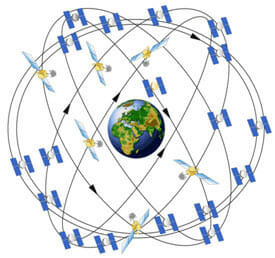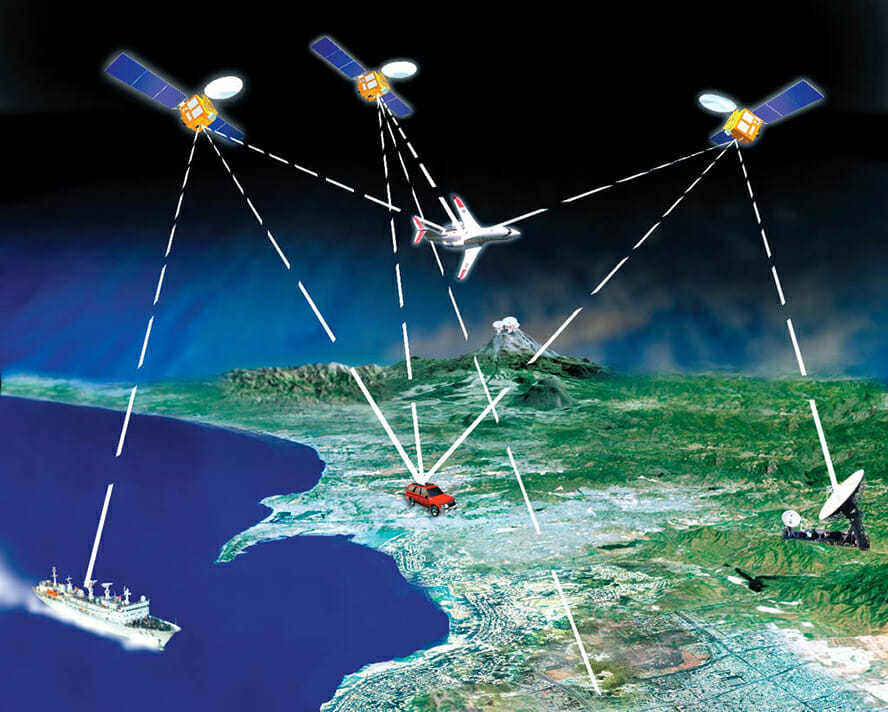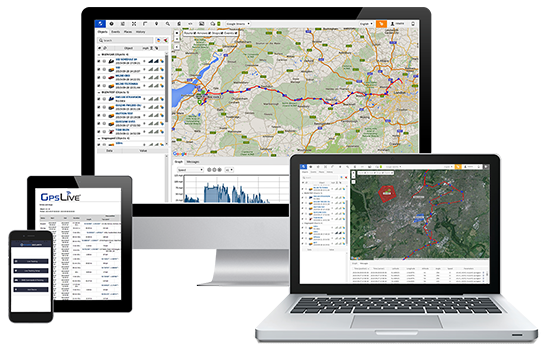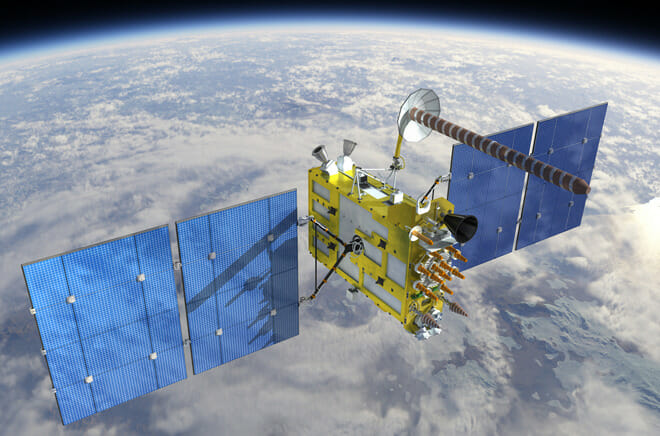Undoubtedly, the Global Positioning System (GPS) has become an integral part of our lives. Thanks to GPS technology, people don’t fear getting lost or exploring a new area, as it can help you navigate to your destination. But GPS is more than just navigation; you can use it anywhere, even your mobile applications.
What seems like a recent invention has been with us for 63 years. Interesting, isn’t it? Read through the entire history of the tracking system.

Development of GPS Tracking Technology
Originally designed for military and intelligence applications at the height of the Cold War in the 1960s, with inspiration coming from the Soviet spacecraft Sputnik back in 1957, the global positioning system (GPS) consists of a network of satellites orbiting the earth at fixed points above the planet and beam down signals to anyone on earth with a GPS tracking device. The history of vehicle tracking systems dates to the start of GPS technology in 1978. when the first experimental Block-I GPS satellite was launched into space. Made by Rockwell International, this satellite system was obviously a successful test; and by the end of 1985, 10 more Block-I satellites had been launched to further confirm the idea of GPS.
In the early years, the technology was yet to be functional because of an insufficient quantity of satellites orbiting our planet. On Jan. 17, 1994, after years of steady growth, the final of the first 24 satellites was launched, and the GPS system was considered completely functional. Today, fleet tracking taps into this exact same technology.
The Public Catches On with GPS Tracking Devices
Early on, GPS technology was designed primarily to be used by the military. The uses for the military were obvious in the 1980s and 1990s, but public curiosity about GPS technology was little. In 1996, President Bill Clinton determined that the system could be an asset to citizens and the military and issued a policy instruction that would require developing a public system benefitting the daily user.
These policy alterations made GPS technology available to the common individual, such as fleet managers, who could see the advantage of using it to monitor their cars.
In the 1990s, additional modifications were made to GPS technology and the devices, including policy and ease of access changes for individual users. In 2006, the final GPS satellite was launched to orbit the earth.
GPS Vehicle and Fleet Tracking
At the beginning of fleet tracking, to be able to correctly track a fleet, every vehicle needed to be enabled with an expensive GPS tracking unit. The company was required to pay a usually high monthly fee to use the satellites for the GPS tracking system. While beneficial, these early systems were hard to implement, expensive to use for the daily user, and often inconvenient for drivers and fleet management businesses. Thus it required several years for the idea to catch on with the vehicle industry. In the first days, only the most prominent and wealthy fleets or companies benefited from the technology.

The basic concept of fleet tracking hasn’t changed since its creation in the 1990s. A GPS tracking system utilises the Global Navigation Satellite System, which incorporates a variety of satellites that use microwave impulses transmitted to GPS units to give info on location, vehicle speed, time, angle, and route history.
Modern Day GPS Tracking Systems
The modern fleet GPS tracking platforms supply the necessary telematics data to fleet management, letting them run their operations more proficiently. Reports on driver behaviour, overall vehicle performance, historical route data, and gas use make it easier for fleet managers to reduce expenses and increase effectiveness for their business.
These systems exceed the simple reporting of each vehicle’s location, providing fleet managers with abundant information about their vehicles and drivers.
Considering the GPS tracker history, fleet managers have a selection of GPS tracking technologies they can use today, including:
- Mobile Tracking — Mobile tracking taps into the growing cell network to provide real-time GPS data through your smartphone.
- Satellite Tracking— Perfect for fleets that regularly travel outside of cellular coverage. Satellite tracking utilises conventional GPS satellites to monitor vehicles. Real-time satellite tracking is quite possible for an affordable price.
- Passive Tracking— Whether satellite or cellular-dependent, passive tracking offers frequent location updates rather than live GPS monitoring information to help with asset management and vehicle tracking.
These three options show the obvious evolution of the technology to the point that it can now accommodate fleets of all types and sizes. But here is a rundown of vehicle GPS tracker aspects you should consider before buying one.

In today’s world, GPS tracking devices are more efficient, able to offer data in real-time and can be accessed to keep track of objects on the move through your smartphone, tablet, or computer. Fleet management experts gain access to a plethora of GPS and telematics data on-demand, making it a viable option for small fleet businesses as well as large companies.
FAQ’s
When did they start putting GPS in cars?
GPS navigation was put in the car way back in 1930 and named Iter Avto. The system worked using paper maps rolled together and displayed on a screen, and a cable was connected to the car’s speedometer that managed the paper maps’ scroll speed. In short, how fast the paper maps moved was directly proportional to the vehicle’s speed.
The drawback during that time was whenever you changed the route, you would have to arrange a new map and identify your exact location on it.
Later in 1981, Honda came up with the world’s first automated commercial navigation system–the Electro Gyro-Cator navigation unit in Japan. This Electro unit worked on a small helium gas gyroscope, and it was more like a device that fighter pilots needed during wars.
Who invented the GPS tracker?
Roger L. Easton is accredited for developing the Global Positioning System (GPS) technology. Roger was leading the space applications of the Naval Research Laboratory and was regarded as the vital person pioneering GPS. Roger was working on the technology that could help track satellites, which can be viewed as similar to what the Soviet Union’s Sputnik was trying to achieve.
He developed a time-based navigational foundation called TIMATION that used circular orbits, passive ranging, and space-borne highly accurate clocks coordinated to a master clock. Basically, a GPS tracker consists of all these elements.
In 2004, former President George W. Bush honoured Easton with the United States National Medal of Technology and Innovation. However, a couple of other people were enlisted into the Hall of Fame for innovating GPS technology.
Dr. Ivan Getting was honoured for creating a cutting-edge system of satellites that would enable precise calculation of location data of vehicles, not limited to just cars. Getting was awarded the Charles Stark Draper Prize for Engineering to appreciate his efforts to make developments in GPS in 2003.
Brad Parkinson led the NAVSTAR GPS Joint Program Office from 1972 to 1978. Since he was the first head of the program, he spearheaded the GPS system’s initiation, development, and execution, earning the title of ‘Father of GPS.’
When did GPS come out for cars?
GPS in cars has been around for more than 20 years. Earlier, what was introduced as GPS navigation has evolved into a proactive system that can help save costs and keep people safe. Before GPS, car owners would keep a physical map in their cars and refer to it if they got lost or went to a new destination.
However, GPS for cars came for public use in the early 1980s–Honda introduced the first GPS map-based navigation in its cars. Since then, GPS in cars has been evolving.
- In 1990, Mazda Eunos Cosmo gave the public a touch screen in the vehicle to see maps along with the ability to use radio, climate control, etc.
- Later in 2009, Sygic for iPhone offered the first detailed navigation for cars. Sygic then collaborated with Skoda and Jaguar Land-Rover to provide customers a more realistic navigation experience.
How long has GPS been around?
The first GPS navigation system, Transit, was tested in 1960 and used by the United States Navy. However, GPS is based on the technology used in LORAN and the Decca Navigator in the 1940s. As ground-based radio navigation systems these were majorly used during World War II.
During the launch of Sputnik in 1957, scientists realised that Sputnik’s signal frequency was higher when it was near the satellite and lower when it went away from the satellite. Using the Doppler distortion, scientists could identify where the satellite is along its orbit by leveraging a human’s accurate location on the globe.
The U.S. Navy created the Timation satellite in 1967 that could set precise clocks in space, and GPS primarily depends on this technology. In February 1978, the first experimental Block-I GPS satellite was introduced to the world.
If we look at the GPS tracking history, GPS technology has been around for more than 50 years. Since then, technological developments and competent scientists have been making advancements in GPS systems.
When were GPS trackers invented?
The history of tracking devices is more than 50 years old. GPS tracking devices were invented in 1968 when an experimental satellite by Rockwell International was launched into space. In 1996, President Bill Clinton authorised the use of GPS tracking devices in the public domain.
Initially, GPS technology was available only to the government and a few organisations; hence, it was treated as a luxury.
The U.S. Navy created the Timation satellite in 1967 that could set precise clocks in space, and GPS primarily depends on this technology. In February 1978, the first experimental Block-I GPS satellite was introduced to the world.
Today, GPS trackers can be used by anyone from car owners and fleets to delivery service providers and aviation. The accuracy and reliability of GPS tracking devices have also improved, and with the advent of 5G, we can expect zero latency.




Good work